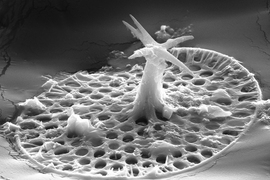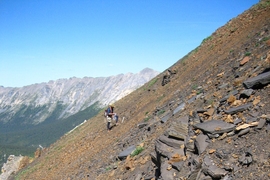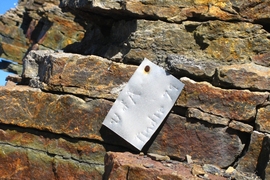In summer 2007, two geologists armed with rock hammers and a shotgun hiked through the Yukon, looking for fossils. For two weeks, Phoebe Cohen, a postdoc in MIT’s Department of Earth, Atmospheric and Planetary Sciences, and Francis Macdonald, an assistant professor of geology at Harvard University, set up camp along the Alaska-Canada border in a remote mountain range accessible only via helicopter.
The shotgun came in handy: Macdonald fired it once to scare off a grizzly bear. And the rock hammers proved invaluable — the team worked them against mountainsides, chiseling out rock samples. They hauled the rocks back to Cambridge and made a surprising discovery: The ancient carbonate contained hundreds of incredibly well-preserved fossils resembling tiny, shield-like plates.
Cohen, who was a Harvard PhD student at the time, says single-celled organisms may have produced the plates as armor, in a process called biomineralization. Today, many organisms have evolved the ability to produce mineral structures: Mollusks generate shells, and mammals and birds form bone. The 700-million-year-old fossils Cohen found may be the oldest evidence of biomineralization; Cohen, Macdonald and co-authors reported the finding this week in the journal Geology.
Plating up
In 1979, researchers from the University of Alaska identified strange fossils in the Yukon region — not in carbonate, but in sections of glasslike rock called chert. But it wasn’t clear then just how old the fossils were. During their expedition, Cohen and Macdonald found the same fossils for the first time in carbonate.
In the lab, they were able to date the rock, and the fossils, to between 717 million and 812 million years old, placing them in the middle of the Neoproterozoic era — a time period in which single-celled organisms likely flourished just prior to the first "Snowball Earth" event, in which vast ice sheets likely covered the planet. Cohen says these microorganisms were most likely killed off in the global freeze, but the fossils they left behind may give researchers clues to the complexity of life just before the planet froze over.
“These fossils … fit in with a huge diversity of other single-celled eukaryotic organisms that seem to have evolved approximately at the same time,” Cohen says.
To get a better look at the fossils, Cohen and Macdonald dissolved rock samples in weak acid, and mounted the residue on stubs. With collaborators at the University of California at Los Angeles, they then created high-resolution, three-dimensional images of the microscopic fossils using scanning electron microscopy. The images revealed plates, each about 20 microns wide, arranged in a honeycomb pattern, with teeth-like spines jutting out and rimming the perimeter.
It’s unclear which modern organisms might be related to these fossils, but on close examination, Cohen observed similarities between the ancient fossil patterns and those formed by modern-day coccolithophores — spherical, single-celled algae found in enormous blooms throughout the ocean. These tiny organisms create mineralized plates within their vacuoles, ultimately extruding the plates to the surface to form protective coverings.
Cohen and her co-authors believe the tiny fossil plates they observed may have formed via a similar process. But exactly why simple organisms evolved such a complex process is still a mystery.
“It takes a lot of effort, energy and just sheer biomass to create these [plates],” Cohen says. “One of the big questions is: Why are these organisms making these intricate, detailed, morphologically complex structures?”
One theory is that spines and plates may help small organisms stay afloat. Today, coccolithophores are found within the photic zone of the ocean, at depths where light can reach. Maintaining a “sweet spot” within this zone enables plankton to grow and thrive — an advantage their ancient counterparts may also have evolved.
The plates may also have served as armor. Hard mineral coverings may have put off predators for two reasons: protective shields simply make it harder to get at an organism, and a plate’s mineral composition may have made the organisms less appealing to nutrient-seeking predators.
“It’s a good possibility that these fossil plates functioned in defense against predators,” says Susannah Porter, an associate professor of geological sciences at the University of California at Santa Barbara who was not involved in the research. “This would be significant if true, for it would be some of the earliest evidence for complex food webs, that consist not only of primary producers … but also organisms that actively prey on other living organisms.”
Cohen hopes the results will spur more researchers to investigate other such early signs of complex life, in rocks of the same time period from around the world.
“These fossils are really small and hard to find,” Cohen says. “And maybe the fossils are there, we just have to look for them.”
Press Contact:
Media Download
*Terms of Use:
Images for download on the MIT News office website are made available to non-commercial entities, press and the general public under a Creative Commons Attribution Non-Commercial No Derivatives license. You may not alter the images provided, other than to crop them to size. A credit line must be used when reproducing images; if one is not provided below, credit the images to "MIT."












